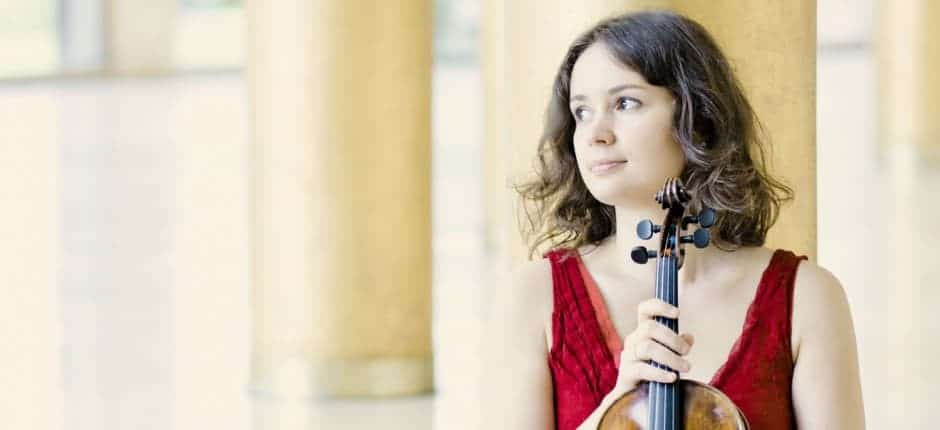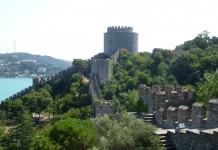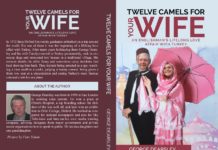This season has been one of the finest and most bountiful of classical music Istanbul has ever witnessed. Over the course of the past several weeks, I have been to performances of Andrea Bocelli, Jose Carreras, the piano legend Murray Perihia, and violin super-stars Maxim Vengerov and Hillary Hahn. I have attended two festivals of Beethoven, and an evening of Tosca honoring the-late Leyla Gencer, one of the greatest sopranos of La Scala. Last Thursday, April 17th, there was another performance at Is Sanat that triggered no less excitement among lovers of strings, and stood out even in this season of abundance: the amazing Patricia Kopatchinskaja and her violin, the fiery Fuensanta “La Moneta” and her entrancing flamenco, the hypnotizing beats of percussion of Agustin Biassera, and the perfect pitch of the Bavarian Radio Chamber Orchestra.
For anyone not familiar with the names: Kopatchinskaja, the highlight of the evening, is an amazing talent of the violin. If you have ever attended a performance of Fazil Say, it is likely that you have also encountered her on the same stage. The two also frequently share the same stage in amazing performances, and have even partnered up in the Say album “1001 Nights in the Harem.” She is prodigiously talented, and is adored for her positive, energetic, mischievous presence on stage. Oh, and for always performing barefoot.

The rest were new but enticing names for me, with “Bavaria” promising the musical perfection of Europe, and “La Moneta” and Diassera, the fiery yet friendly energy of Granada’s flamenco.
The evening started out with the Bavarian chamber orchestra, performing the six-minute Navarra of composer Sarasete– with first and second violin chairs, (Radowlow Szulc and Korbinian Altenberger) engaged in a duet. An advantage of having a small chamber orchestra on the stage was the possibility to hear individually each ten of the string instruments on stage. The piece was a lovely, witty one, befitting the spirit of the coming of the spring season.
Then began the series of surprises. The Bavarian chamber orchestra left the stage barren. The lights dimmed, -or rather, blackened,- until the happenings on stage became barely visible. A big drum set was dragged on to the stage, and when we strained our eyes, we made out the figure of Agustin Diassera alongside it. And…. a silhouette began to tread across the stage in silence. A slim, petite white figure, barefoot.
Wow! Having Kopatchinskaja on stage was exciting enough. But, it was apparent that there would also be some drama involved as well. The stage was dim, the figures were visible, but only without detail. We, the audience, were in pitch black. The “Luz sobre lienzo,” (Light on canvas) of Mauricio Sotelo began with the low-decibel hums and whistles of the violin. It sounded as if Kopatchinskaja was bowing the string with the back, wooden side of the bow, as opposed to the usual side of horse hair. I was on the fifth row with a good view. I squinted to make out the detail, but it was indeed too dim to make out the difference. It was a piece in perfect harmony with the mischievous presence of Kopatchinskaja!
Then the hums, whistles, and notes of eeriness, humour and foreshadowing action came to a halt, and Patricia vanished in the darkness as Fuensanta made her entrance on stage! A swaying black skirt, a see-through top, and the strongest, sharpest, and the most hypnotizing of expressions on her face. It was an expression transfused into the rest of her body, felt in the power, intensity and vibration of her every move. She twisted, turned, swirled. At times, there was no music at all, but only the rhythm of Fuensanta’s feet – in motion at the speed of lightning and with the precision of a master – creating the most artistic, most rhythmic and musical of sounds against the floor. There was also the clicking of castanets, but these were created with the sounds of her bare fingers. Diessera’s percussion uttered rudimentary, instinctual beats, reflecting the beat of our innermost consciousness. Kopatchinskaja’s notes screeched and thundered notes unique only to this composition. And the dancer brought out the fire, the intensity, the emotion of all this in the movements of her body and the intensity of her expression. The piece lasted only twenty-minutes, but encompassed the most powerful, primitive and intense of feelings and instincts of one’s lifetime.
After the interval, we were back to “normal” and Kopatchinskaja teamed up with the Bavarian Radio Chamber Orchestra in Mozart’s Violin Concerto #4 in D Minor, KV 218. Mozart’s immaculate composition brought out to day again, this time with the talented musicians of Bavaria, and the notes of Kopatchinskaja in the solo parts. Once in awhile Kopatchinskaja took off with her own style – with a look of mischief, and more staccato, more vigor, more fire. I remembered her statement that “the certain taboos in music had to be broken” and that music played “the way it was originally composed.” A performance carrying the energy, the wit, the vigor of Mozart into a performance of our present day… Her selection was Bela Bartok in the encore, and first violin chair Szulc backed her up as the second violin in the duet of bows and pizzicati.
An evening out of this world ended with the style and energy of Piazzola and the warmth and energy of Buenos Aires. The Bavarian Radio Chamber Orchestra performed solo the Quatro Estaciones Portenas (The Four Seasons of Buenos Aires) of Astor Piazzolla. “Winter” was no other than the original version of the piece brought into popularity by Vanessa Mae in her stormy video “Storm.” Spring took us to the joy and sprightliness of the rebirth of nature. The first first violin solos were fast and vivacious, and the cellos and double bass got creative, clanking their bows on their instruments. A viola solo wowed us with elegant, eloquent notes that blended the beauty and harmony of new life with the melancholy of lives left behind in winter. Summer was peaceful and lazy; autumn announced not only the end of the year in Buenos Aires, but the finale of this superb evening.
Melis Kanık is a contributor for Yabangee.










